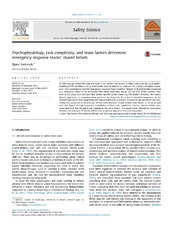| dc.contributor.author | Sætrevik, Bjørn | |
| dc.date.accessioned | 2016-01-04T13:23:24Z | |
| dc.date.available | 2016-01-04T13:23:24Z | |
| dc.date.issued | 2015-05-02 | |
| dc.Published | Safety Science 2015, 78:117-123 | eng |
| dc.identifier.issn | 0925-7535 | |
| dc.identifier.uri | https://hdl.handle.net/1956/10859 | |
| dc.description.abstract | In field settings where the objective truth is not known, the extent to which you have the same understanding of the situation as your team leader may be used as an indicator for a team’s situation awareness. Two experiments showed emergency response team members’ degree of shared beliefs (measured as a ‘similarity index’) to be associated with which team they are in, but not with which position they have in the team. This indicates that factors specific to the teams, e.g. the leader’s behavior, the team’s shared experience, or communication patterns, are important for a team’s situation awareness. In the second experiment, task complexity was manipulated with a scripted scenario design and heart rate variability was measured as an indicator of executive function. Shared beliefs were shown to be associated with the degree of high frequency modulation of heart rate variability. Further, shared beliefs were associated with the designed task complexity for some teams. The experiments showed no association between the measure of shared beliefs and subjective reports of situation awareness. | en_US |
| dc.language.iso | eng | eng |
| dc.publisher | Elsevier | eng |
| dc.rights | Attribution CC BY | eng |
| dc.rights.uri | http://creativecommons.org/licenses/by-nc-nd/4.0 | eng |
| dc.subject | Situation awareness | eng |
| dc.subject | Shared mental models | eng |
| dc.title | Psychophysiology, task complexity, and team factors determine emergency response teams' shared beliefs | eng |
| dc.type | Peer reviewed | |
| dc.type | Journal article | |
| dc.date.updated | 2015-12-22T10:30:48Z | |
| dc.description.version | publishedVersion | |
| dc.rights.holder | Copyright 2015 The Author | eng |
| dc.identifier.doi | https://doi.org/10.1016/j.ssci.2015.04.017 | |
| dc.identifier.cristin | 1237166 | |
| dc.subject.nsi | VDP::Medisinske Fag: 700 | |
| dc.subject.nsi | VDP::Samfunnsvitenskap: 200::Psykologi: 260::Sosial- og arbeidspsykologi: 263 | |
| dc.subject.nsi | VDP::Social sciences: 200::Psychology: 260::Social and occupational psychology: 263 | |

